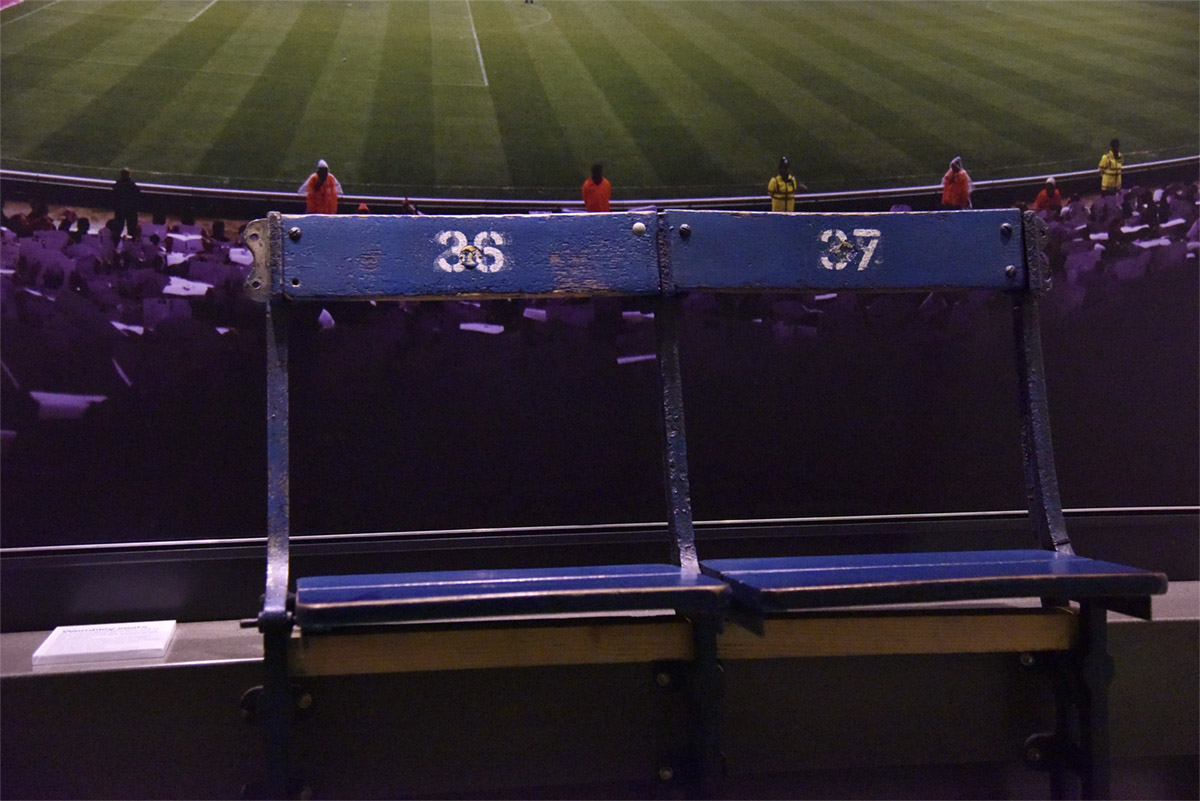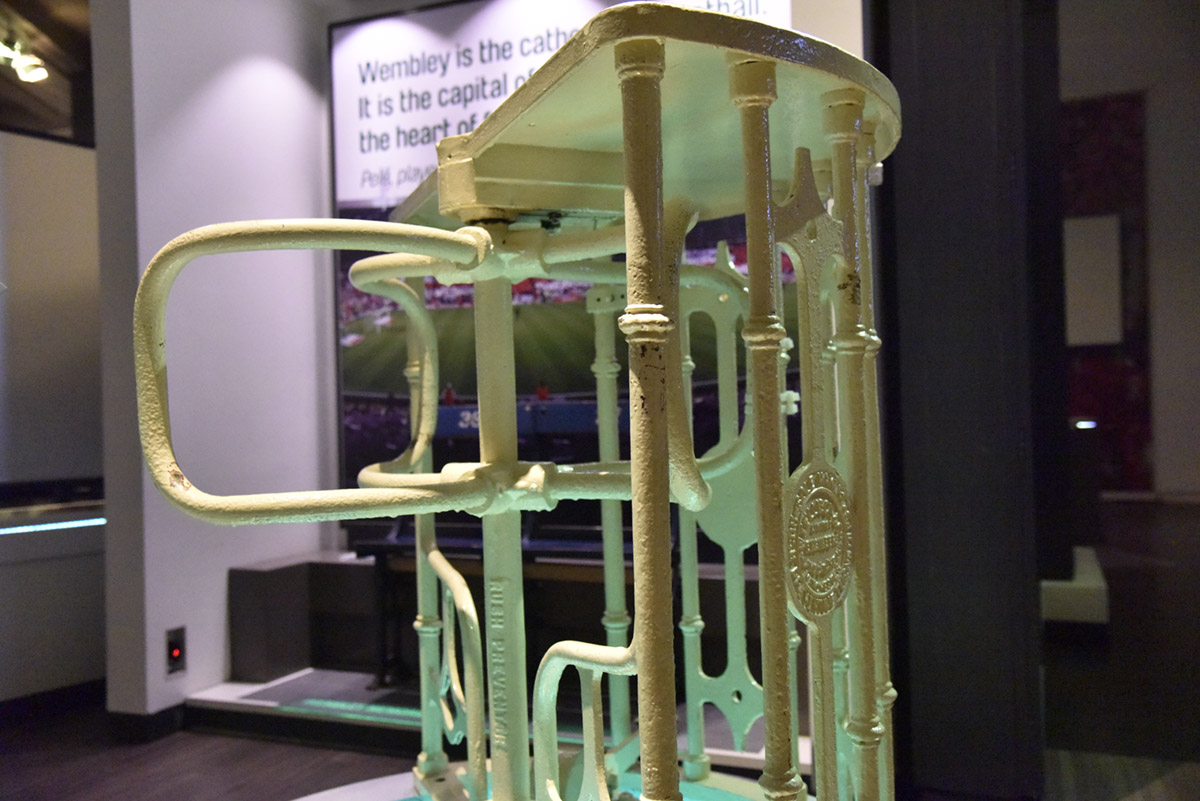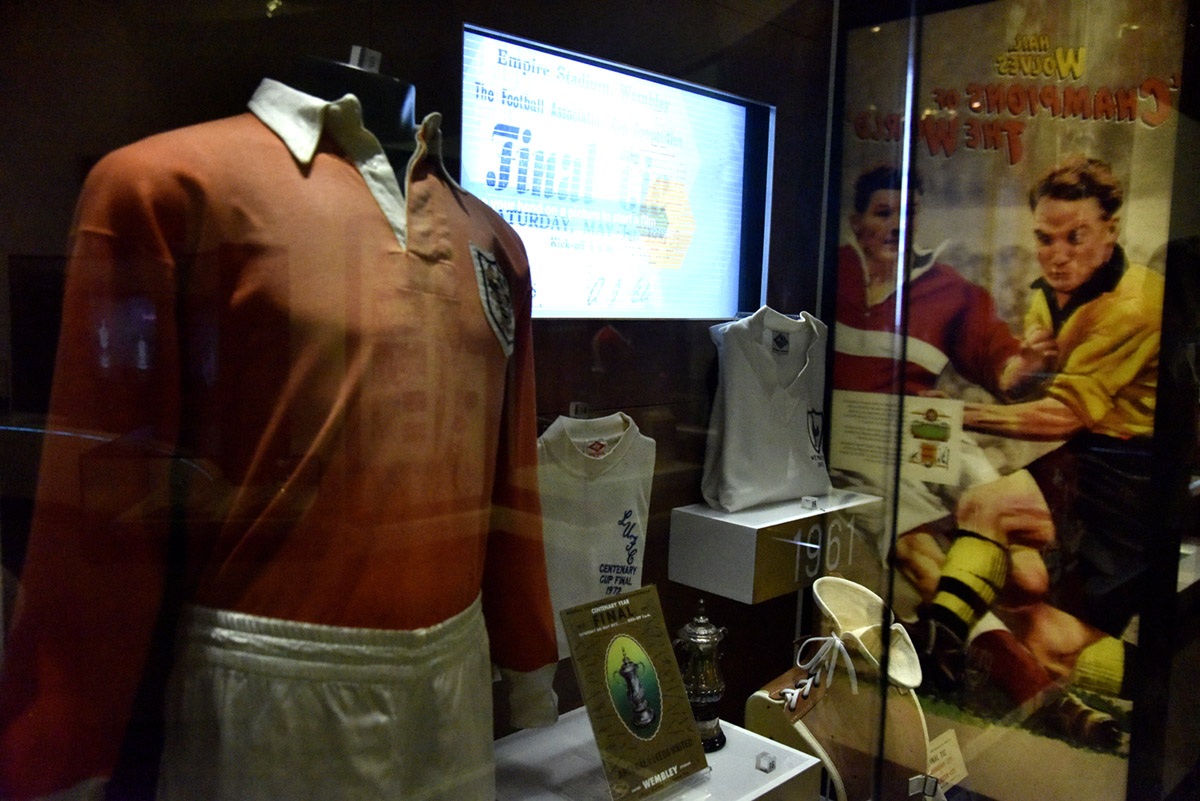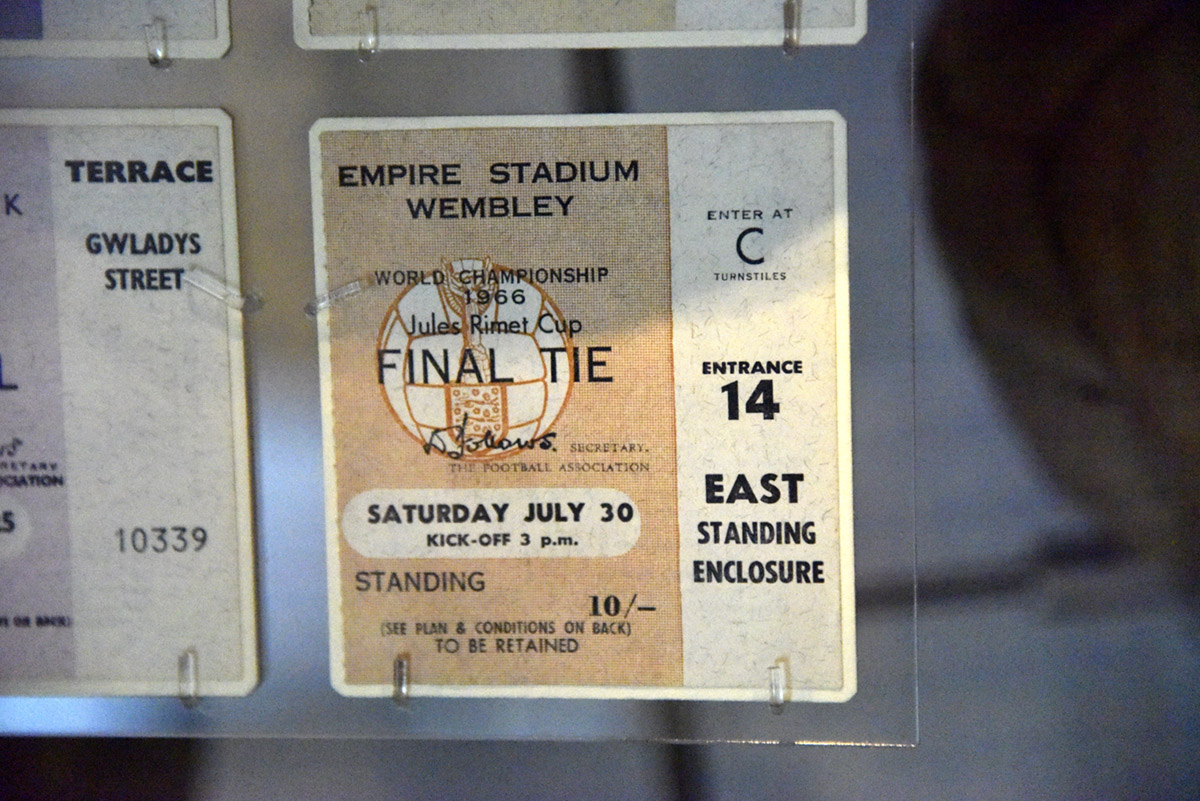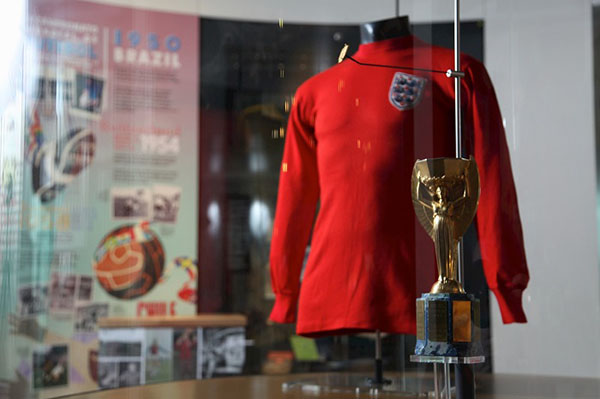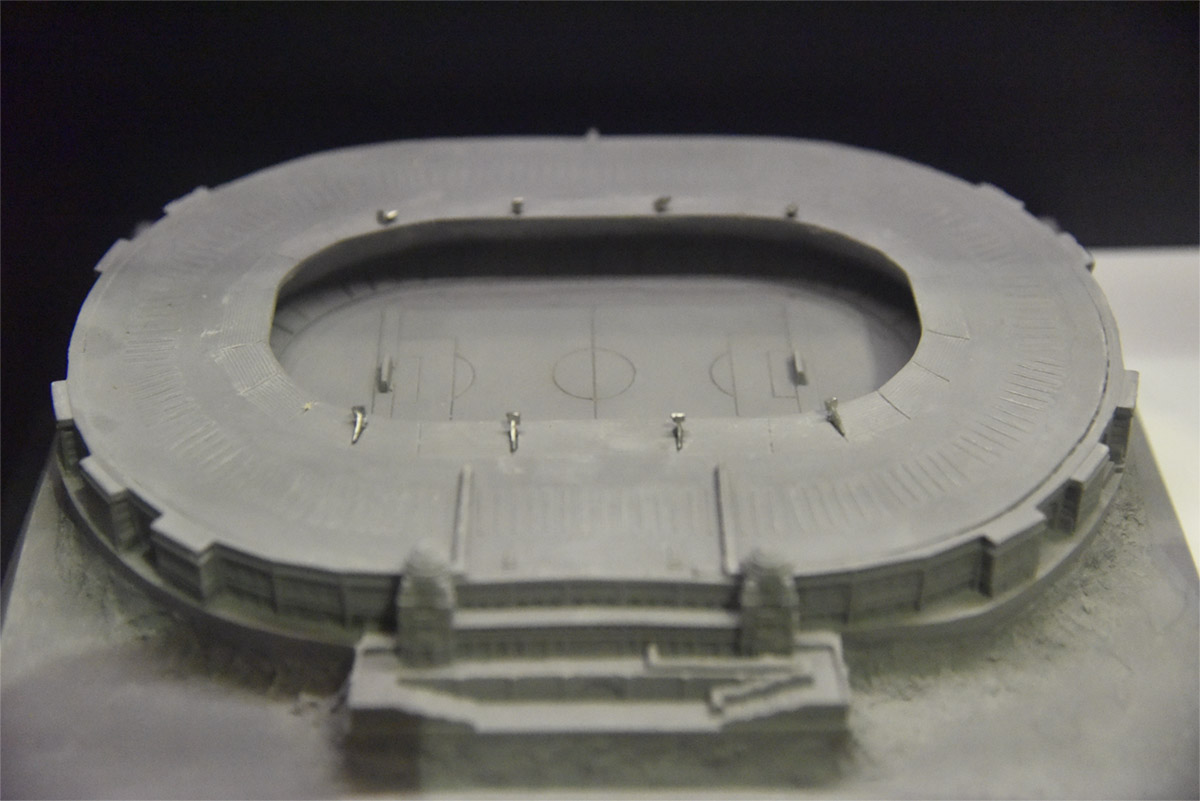Wembley 100: Objects on display Calendar
24 Apr 2023
As part of Wembley 100, the National Football Museum takes a look at a century of the stadium’s remarkable history – via objects you can see every day on our galleries…
Original seats and turnstile
Visitors can take a seat and experience what it was like for fans of yesteryear at Wembley. These wooden chairs are two of around 82,000 seats installed in the original stadium, then known as the Empire Stadium.
The venue itself was built as part of the British Empire Exhibition of 1924/25, which served to promote the country and its colonialism. The Prince of Wales had called for a “great national sports ground” as part of the exhibition: the stadium’s legacy would in time outstrip that of the exhibition itself, putting Wembley – a north-west town eight miles from the capital city centre – very much on the map.
Though the official seating capacity was 82,000 seats, standing capacity was far greater. At the first major event in 1923, the official attendance was registered as 126,000 – but thousands more fans turned up to see West Ham United take on Bolton Wanderers in the FA Cup final. Some estimates suggest more than 200,000 packed into the stadium, overflowing onto the pitch and delaying kick-off.
The museum is also home to one of around 100 of the original turnstiles from the 1923 installation. It is a great example of an original ‘rush preventive turnstile’ patented by W T Ellison in Salford at the end of the 19th century. We suspect many of these were bypassed in that first FA Cup final!
Stanley Matthews’ FA Cup medal
Prior to the construction of Wembley, FA Cup finals were played at ten different venues. The Oval (of cricket fame) was the most frequently used ground during the late nineteenth century, before Crystal Palace became the stadium of choice from 1894 onwards. Stamford Bridge played host to the first two post-war FA Cup finals, but Wembley would soon become the ultimate destination for players and supporters alike.
The stadium bore witness to the FA Cup’s greatest games – and few were greater than the ‘Matthews final’ of 1953. Trailing Bolton Wanderers 3-1 early in the second half, the veteran winger inspired Blackpool’s remarkable fightback, laying on two assists in the 4-3 turnaround.
In the post-match celebrations, Matthews was hoisted aloft by his teammates, showing this medal to the sky in a nod to his late father. That medal, along with Stan’s kit from the final, lives at the heart of our FA Cup display.
Danny Blanchflower’s 1961 shirt
From 1954 onwards, FA Cup final shirts were increasingly adorned with Wembley-related embroidery, rendering those match-worn shirts unique and highlighting the strong bonds between the FA Cup and the iconic stadium.
Tottenham Hotspur had won the competition twice – first as a non-league outfit at the turn of the century, and again in 1921 – but had to wait another forty years to run out at a Wembley final. Spurs had comfortably wrapped up the First Division some weeks prior: a win over Leicester City in the FA Cup final would clinch the first Double of the twentieth century.
Despite heading into the game as overwhelming favourites, Bill Nicholson’s side only started to impose themselves after Foxes full-back Len Chalmers sustained an early injury. With substitutes not yet permitted, Leicester were effectively a man down, allowing Spurs to gain the upper hand. Second-half goals from Bobby Smith and Terry Dyson proved enough to see off their stubborn opponents.
Skipper Danny Blanchflower climbed the 39 steps and lifted the trophy whilst wearing this shirt. He would repeat the feat in 1962, before captaining the side to further glory in 1963’s European Cup Winners’ Cup.
1966 World Cup final ticket
Despite its prestige, significant capacity and capital city location, Wembley was not immediately considered to be the home of English football. In the decade after the Empire Stadium’s construction, the national side played at various grounds, including The Hawthorns, Turf Moor, Bramall Lane and Bloomfield Road. In fact, for the first 28 years of Wembley’s existence, the only England fixtures taking place there were against Scotland.
That changed in May 1951, when 99,000 supporters headed to London to see the Three Lions defeat Argentina. From then on, almost all England games would take place in the capital. When England hosted the World Cup in 1966, visiting nations would play at Ayresome Park, Goodison Park and Villa Park – but Alf Ramsay’s men played every one of their fixtures at Wembley.
It was the backdrop for the greatest moment in English football history: our first (and to date only) World Cup triumph. Over 96,000 lucky supporters had one of these tickets to the Wembley showpiece, with 32 million more watching eagerly in their homes.
Underneath the twin towers, England emerged victorious in one of the tournament’s most famous victories – a cultural touchstone for an entire generation. This ticket can be found as part of our England on the World Stage display, alongside one or two other rather significant items…
England v Germany 2000 programme and DFB gift
As the millennium approached, plans were drawn up to replace the old Wembley – which had outlived the original exhibition by the best part of a century – with a modern 90,000-seat successor, featuring a bowl-shaped design and a retractable roof.
The final game prior to the original stadium’s demolition took place in October 2000. Fittingly, the final visitors were Germany, making the trip across the Channel for a World Cup qualifier. The match itself could not have been further from the pulsating action of 1966: an early goal from Dietmar Hamann saw Wembley (and England manager Kevin Keegan) bow out with something of a whimper.
This programme from the game is on display in our Stadiums section, alongside a thoughtful gift from the DFB, mark the final fixture at one of the game’s greatest grounds.
A model of Wembley Stadium, sculpted from the concrete rubble following its demolition.

